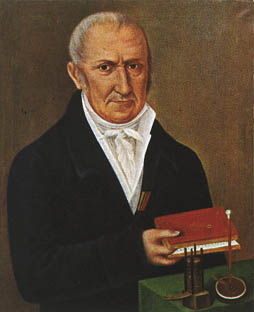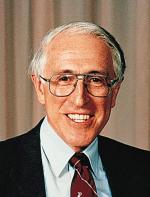| Volta's
crazy experiments
Interest in stimulating hearing with electricity
began with Count Volta in the 18th century.
Volta, an Italian physicist who developed
the electric battery, connected batteries
to two metal rods that he inserted in his
ears. In 1800 he described that when the
circuit was completed he received a 'jolt
in the head' and then a sound 'a kind of
crackling, jerking or bubbling as if some
dough or thick stuff was boiling' (Epstein:1989:
34). Not surprisingly, Volta found that
it was quite uncomfortable and did not repeat
the experiment too often!
Fifty
years after Volta, a Frenchman, Duchenne
of Boulogne, tried using an alternating
current to stimulate his hearing and heard
what he described as a sound like an insect
trapped between a glass pane and a curtain.
|
 Alessandro
Volta
Alessandro
Volta |
Stimulating
the auditory nerve
The first direct stimulation of the auditory nerve
in a human was performed during an operation by
Lundberg in 1950 - the patient became aware of
noise. In 1957, Djourno and Eyries implanted an
electrode attached to an induction coil in the
head of a deaf person. They were able to transmit
a signal to the electrode via a radio antenna
on the outside of the body. The person heard sounds
resembling the chirping of a grasshopper or cricket.
He was also able to recognise simple words like
mama, papa, and allo. This experiment
inspired many investigators about the possibilities
of using implanted prostheses to enable deaf people
to hear.
An
important trial with multiple electrodes stimulating
the cochlea was successfully performed by American
surgeons, John M Doyle, William F House and an
electronic engineer, James Doyle. In 1964 Dr F
Blair Simmons et al (Stanford University Medical
School) implanted six electrodes with success.
The recipient could recognise simple tunes. This
research increased the knowledge of how the brain
coded frequencies and responded to electrical
stimulation.
There
was much more work done in the 1960s and 70s to
increase knowledge of how the cochlea functions
and how speech is perceived. Studies led to the
idea that the best way for a profoundly deaf person
to hear speech is by stimulating the auditory
nerve using a multiple electrode device. Research
in:
- electrical
and mechanical technologies
- progress
in materials technology and
- experiments
with pacemaker implants also increased the opportunities
to advance with cochlear implants.
For
more information on hearing experiments: http://www.medoto.unimelb.edu.au/info/history2.htm
Cochlear:
an Australian innovation success
An Australian, Graeme Clark, was greatly inspired
by Dr F Blair Simmon's work with multiple electrode
implants. Graeme Clark's father was hearing impaired,
he had sensori-neural deafness. His father was
a pharmacist and often had to ask his customers
to speak up about their medical problems,
which embarrassed him and them.
|
In
1967 Clark embarked on a long journey towards
fulfilling his dream of helping deaf people
hear the spoken word again. As a
PhD student at the University of Sydney,
Graeme Clark reviewed the available research
to 'investigate whether a single or multiple-channel
(electrode) cochlear implant would be possible
for the management of a profound hearing
loss.' (Clark, 1969: 1)
He
believed that implants on humans should
not be done until basic research on animals
had solved some of the problems. For ten
years his research into electrical stimulation
of the auditory nerve via an implant into
the cochlea struggled along on animal experiments
and university grant funding.
|

Graeme
Clark
Courtesy: Department of Otolaryngology,
The University of Melbourne.
|
|
Funding
the project
In 1974 a telethon on Channel 10 in Melbourne
generated enough funds to take his work to the
prototype stage and in 1978 to test it in a human
patient, Rod Saunders. The cochlear implant worked:
Rod could perceive sound again.
|
This
demonstration encouraged the federal government
to finance commercialisation of the cochlear
implant. The financing of the cochlear implant
became a remarkably successful joint venture
to manufacture and market the product. The
three-way partnership was begun between
researchers at the University of Melbourne,
the Federal government and a medical equipment
exporter called Nucleus. The researchers
provided the scientific expertise, Nucleus
contributed experience in making and selling
advanced medical equipment and the government
provided project management and over a million
dollars in grants.
This
partnership led to the formation of a string
of Cochlear enterprises in the US, Japan
and Switzerland including Cochlear Ltd in
Australia.
|

Cochlear
enterprises around the world. (Cochlear Pty
Ltd) |

Cochlear logo
(Cochlear Pty Ltd) |
The
Nucleus® 22 was introduced in 1983 and was
the first use of a 22 channel implant. Since then
the Australian cochlear implant system has been
used by over 30 000 people in 50 countries. It
is the world's most widely used cochlear implant
system. By the early 1990s Cochlear Ltd was making
a profit and Professor Clark was earning royalties.
The
success continues
Features of the Nucleus® 22 Cochlear Implant
System include:
- Internal
implant with 22 channels for more stimulation.
More channels give more flexibility in programming,
more pitch information and improved hearing
in noisy situations.
- SPEAK
speech coding strategy, designed to improve
speech comprehension, especially in noise.
- A
long history of speech processor upgrades including
the Spectra, a lightweight, powerful body worn
speech processor and ESPrit 22, a compact, ear
level speech processor. (Cochlear, 2001)
|
In
1994, after five years of lobbying, the
implant was approved by Japanese health
insurance companies, opening up a market
of up to 50 000 profoundly deaf people.
Nucleus®
24 Contour, introduced in 1999 uses a pre-curved
electrode. The electrode is made with the
curved shape of the cochlea, improving the
sound quality and simplifying surgery. The
design won the Australian Design Award™
of the Year 2000.
In
Australia, Cochlear Ltd design in accordance
with the Implantable devices standard and
the European Cochlear implant standard.
|

Nucleus® 22 (Cochlear
Pty Ltd) Click image to view detailed pdf
|
Activity
Draw a timeline to summarise the history of cochlear
implant technology, beginning with Volta's experiments.
|